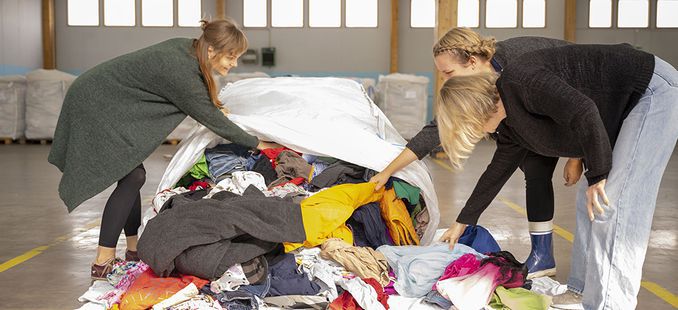
Textile flows in Finland: the consumption of textiles is steady, the amount of textile waste on the rise
In Finland, the consumption of clothes and household textiles has remained at the level of 2012. Instead, the collection of end-of-life textiles from households has increased. The overall use of textiles was studied for the first time in Finland and in 2019, it was 130 811 tonnes.
The textile flows in Finland were mapped in the Textile Flows in Finland project after a break of almost 10 years. The report, which was completed in 2021, contains data collected in 2019. The previous report is based on data from 2012.
According to the study, in 2019, Finns consumed 11.3 kg of clothes and household textiles per capita. In 2012, the amount was 11 kg. The combined amount of consumed clothes, household textiles and other equivalent textile products in households, companies and the public sector has been about 60 000 tonnes in both years of comparison.
- The information on the development of consumption is conflicting. The operators in the fashion trade industry have seen a declining trend in their own statistics, whereas the number of euros spent on clothes in the data of Statistics Finland seems to remain steady and is even on the rise. In addition, it must be noted that foreign online stores are completely excluded from the information from 2012, and in this latest report, we have tried to evaluate their usage. The fact that online stores are missing seems to indicate that the figure from 2012 should have been bigger, says Senior Research Scientist Helena Dahlbo from the Finnish Environment Institute.
The report on the textile flows in Finland has been compiled by experts from the Finnish Environment Institute, Turku University of Applied Sciences and Southwest Finland Waste Management (Lounais-Suomen Jätehuolto). In the report, a method developed by the Nordic countries in cooperation has been utilized to examine clothes and household textiles, which enables the international comparison of these results.
According to Helena Dahlbo, in Finland the amount of clothes and household textiles is small compared to the other Nordic countries. When in Finland the annual usage of textiles is 11.3 kg per capita, in Sweden the equivalent number is 12.8 kg and in Norway and Denmark 15 kg.
Significant increase in the collection of end-of-life textiles from households
The textile flows report contains statistical data on the production, export and import of textiles and clothes. Information on the amounts of end-of-life clothes and household textiles collected from consumers has been collected from the operators in the textile chain.
According to the textile flows report, the separately collected amounts of end-of-life textiles from households have increase by approx. 39% from 2012. In 2019, about 44% of clothes and household textiles purchased by households ended up in the separate collection of end-of-life textiles.
End-of-life textiles refer to both textiles suitable for reuse and textiles classified as textile waste. In principle, clothes and household textiles which will be reused are mainly collected by charity organizations, whereas textile waste is collected by waste companies.
The overall use of textiles in Finland was 130 811 tonnes
The textile flows in Finland were now studied for the first time in their entirety. In this report on the total volume of textile flows, the usage of textiles by the industry was also considered besides clothes and household textiles.
In total, the Finnish economy in terms of textiles and clothes is strongly linked to foreign trade. Two thirds of the net supply are imported products. 75% of textiles and clothes are used in Finland and the rest exported. Households are responsible for more than 50% of the domestic consumption.
In total, the amount of end-of-life textiles was 85 770 tonnes in 2019. Of this, 18% were exported and the rest remained in Finland to be reused or utilized as materials or energy. About 60% of all end-of-life textiles still ended up incinerated.
The report serves the development of textiles’ circular economy
Up-to-date information on the consumption of textiles and clothes and the amount of end-of-life textiles are essential for the development of textiles’ circular economy and planning future actions. The data also helps with preparing for the Finnish Waste Act, which will undergo a reform, and will require carrying out separate collection of textile waste from 2023.
The separate collection of end-of-life textiles by waste management companies is expected to develop significantly in the upcoming years. In addition, novel solutions for the flows of end-of-life textiles will be launched in Finland already this summer, when the operations of the first refining plant in the Nordic countries for treating collected end-of-life textiles will start in Paimio.
The refining plant in Paimio will be a new solution for refining end-of-life textiles into raw materials: textiles will be processed into recycled fibres for different industry purposes. At the same time, it provides a solution for the recycling of textiles.
